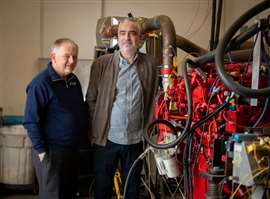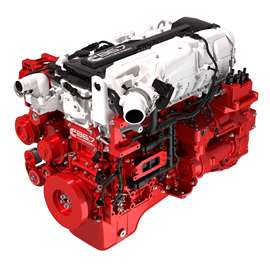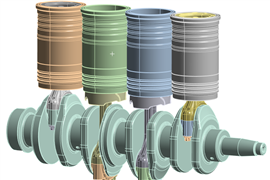Read this article in 中文 Français Deutsch Italiano Português Español
New alliance between academia and industry looks to advance H2 in North America
21 March 2025
Officials at the University of California, Riverside (UCR) and University of Michigan have joined with several industry partners to launch the Hydrogen Engine Alliance of North America (H2EA-NA). The alliance is intended to promote hydrogen (H2) as a viable alternative fuel for internal combustion engines (ICE) while supporting the transition to electrification and other zero-emission technologies.
 Wayne Miller, left, and Georgios Karavalakis, in the heavy-duty engine dynamometer room of the Center for Environmental Research and Technology (CE-CERT) at the University of California, Riverside (UCR). (Photo: UCR/Stan Lim)
Wayne Miller, left, and Georgios Karavalakis, in the heavy-duty engine dynamometer room of the Center for Environmental Research and Technology (CE-CERT) at the University of California, Riverside (UCR). (Photo: UCR/Stan Lim)
“Our goal is to leverage hydrogen as a low-carbon solution that can enhance the performance and sustainability of internal combustion engines,” said Georgios Karavalakis, co-director of H2EA-NA and professor of chemical and environmental engineering at UCR. “Hydrogen-powered ICEs can provide a long-term, reliable solution, particularly for applications where battery-electric or fuel cell vehicles may not meet consumer performance requirements.”
Karavalakis brings expertise in combustion engines, low- and zero-carbon fuels and transportation emissions to H2EA-NA. Another co-director will be Wayne Miller, also a professor of chemical and environmental engineering at UCR. Miller is a specialist in zero-carbon fuels, transportation emissions and marine systems.
“Hydrogen combustion engines are a critical component of the clean energy transition, offering a practical solution for sectors where electrification is not yet feasible,” he said.
Joining them from the University of Michigan as a co-director will be André Boehman, a professor of mechanical engineering. Boehman’s research focuses on alternative fuels, fuel production and energy conversion system thermodynamics.
“Our alliance will promote the advantages of hydrogen-powered ICEs,” he said. “By fostering innovation and collaboration across sectors, H2EA-NA will ensure that ICEs contribute meaningfully to North America’s hydrogen ecosystem and transportation goals.”
By bringing together leaders from the automotive, energy, and government sectors, H2EA-NA said it aims to educate the public about hydrogen’s potential in the U.S. and build support for hydrogen infrastructure development.
Other founding members of the alliance include industry partners with expertise in building efficient engines to operate with hydrogen. These include Cummins, Daimler Truck North America, Mahle and Tenneco.
 Cummins B6.7H hydrogen engine (Photo: Cummins)
Cummins B6.7H hydrogen engine (Photo: Cummins)
According to Tenneco’s Steven Krause, executive director of sales and strategy, the University of Michigan first contacted Tenneco about a possible membership in the H2EA-NA. He said that Tenneco maintains relationships with several universities that are involved in advanced engine research.
“Our decision to help was rooted in both strategic business interests and industry-wide needs,” Krause said. “Hydrogen internal combustion engines provide a practical, scalable solution for industries when other alternatives, like battery or fuel cells, face limitations. H2-ICE allows us to support our customers with low-emission, high-performance solutions to address challenges of power and range while leveraging existing supply chains and infrastructure.”
Imon Uduehi, general manager for the alternate fuels and fuel delivery systems at Cummins, said the engine builder is making investments in hydrogen so that it is ready for when the market demands H2-fueled engines.
“We believe integrating H2-ICE into a domestic, energy-secure system would promote accelerated infrastructure development resulting in wider adoption. Cummins is excited by the collaborative impact our participation in founding the H2EA-NA can have on empowering the acceptance of this critical technology among the multiple solutions required to decarbonize the commercial industry.”
Daimler Truck North America (DTNA) said the company looks to help shape the future of transportation via the right technology, at the right time, for the right applications.
“The Hydrogen Engine Alliance focuses on education and sharing the latest research findings on hydrogen ICE,” said a spokesperson for DTNA. “This helps raise awareness and informs both the public and stakeholders about hydrogen ICE. By uniting leaders from the automotive industry, energy sectors and government agencies, the alliance fosters collaborative projects that drive technological advancements across North America.”
 André Boehman, professor of mechanical engineering at the University of Michigan. (Photo: University of Michigan/Marcin Szczepanski)
André Boehman, professor of mechanical engineering at the University of Michigan. (Photo: University of Michigan/Marcin Szczepanski)
Membership provides access to the latest technologies, market trends, and evolving industry standards. Tenneco hopes its membership in H2EA-NA will yield practical outcomes.
“Through this collaboration, we hope to demonstrate the real-world viability of H2-ICE technology,” Krause said, “while supporting industry and policy alignment, advancing infrastructure and strengthening supply chains to drive economic growth and environmental progress in the years ahead.”
Countries such as China, Germany and Japan are at the forefront of hydrogen fuel development, H2EA-NA said, with the U.S. lagging in innovation. The alliance cited Germany’s Allianz Wasserstoffmotor, which was established in 2021, and the European Clean Hydrogen Alliance launched a year earlier — both of which serve roles similar to H2EA-NA.
“The U.S. has immense potential to lead in hydrogen fuel innovation, but significant barriers in infrastructure, policy, and public awareness have slowed progress,” Karavalakis said. “While the technologies exist, they are costly due to complexity and the need for expensive raw materials.”
Funding for H2EA-NA will come through annual membership fees from participating companies, with funds directed to the nonprofit UC Riverside Foundation. The fees will be equally split between UCR and the University of Michigan to support alliance operations, H2EA-NA said.
POWER SOURCING GUIDE
The trusted reference and buyer’s guide for 83 years
The original “desktop search engine,” guiding nearly 10,000 users in more than 90 countries it is the primary reference for specifications and details on all the components that go into engine systems.
Visit Now
STAY CONNECTED




Receive the information you need when you need it through our world-leading magazines, newsletters and daily briefings.
CONNECT WITH THE TEAM













